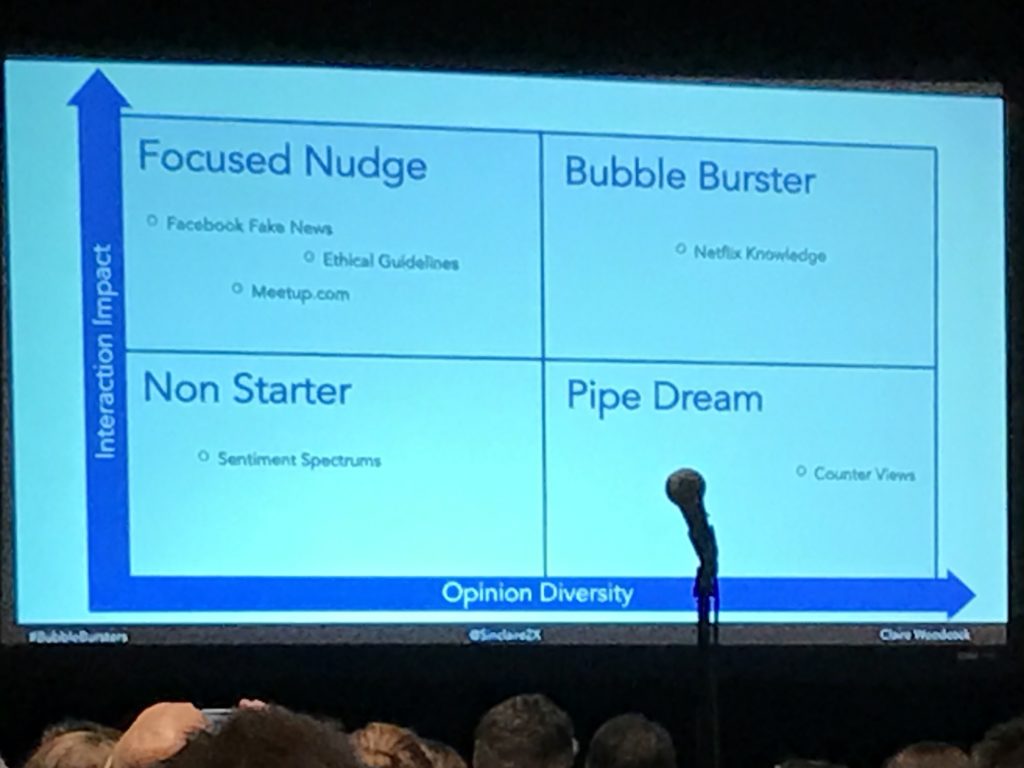
“Echo chambers” is a hot term in this post-election world we live in. There’s little debate they exist – these bubbles we live in, primarily on social media, full of groupthink – or the role social networks like Facebook play in forming them, but there’s been little discussion on solutions for this problem.
Enter Claire Woodcock.
Woodcock, a strategy manager and technological consultant from London, presented her ideas to burst the bubble on echo chambers. According to her, affecting those social media algorithms depends on the relationship between interaction impact and diversity of opinion.

On the X-Y diagram, content with the lowest interaction impact and diversity of opinion is a non starter. Sentiment spectrums are a prime example of this – content that already “confirms” your preconceived notions about a topic or issue. If you are conservative, you likely get news (real news, that is) or commentary from people who think like you do. Same with liberals. There’s no diversity of opinion here, and the interaction impact is quite small. It just “proves” what you already believe.
Content that does have a diversity of opinion but low interaction impact is a pipe dream. These are views that counter ours or are from outlets we don’t like, respect or trust, and we typically dismiss them without consideration.
Higher on the interaction impact scale, yet with low diversity of opinion, is content Woodcock called a focused nudge. Items like fake news that pops up on Facebook falls here. This content is often too unbelievable to be true – with good reason, since it typically isn’t. But we fall for it because it’s sensational and makes us believe the worst of our suspicions or concerns of “the other side.” Therefore, it has high interaction impact, since we tend to share to show others the things we knew had to be happening actually ARE happening. (But, in reality, they’re not.) Woodcock cited a Columbia University statistic that 59% of people who share links on Facebook haven’t actually clicked the link to read the story. Why would you? The headline already confirms what you want to see and want to share with others.

Finally, content with the highest interaction impact and diversity of opinion is the bubble burster. Woodcock suggested the Netflix Suggestions model could work in transforming our social news feeds. As you may know, Netflix solved its own echo chamber problem, people watching the same, most popular shows instead of finding new content, by developing its recommendations algorithm. Now, it compares what content you watch with other similar viewers, and finds common ground between the two of you to suggest what to watch next. If you like action movies with strong lead characters and strong villains and just watch a James Bond movie, Netflix will find someone else who also watched Bond, likes action movies with strong leads and villains – and just watched Star Wars. Therefore, you will also likely enjoy Star Wars. Woodcock used the Brexit vote to show this from a news standpoint. Using herself as an example, she listed the following qualities: She was interested in Brexit, interested in cars, wanted a job promotion, reads the Wall Street Journal but didn’t read pro-Brexit content. David, a person who lives in north England, also was interested in Brexit, cars and a job promotion. He doesn’t read the Wall Street Journal, but he does read pro-Brexit content. Using this Netflix suggestion model, a social media algorithm could determine these two people have enough in common to find content to break them out of their echo chambers. Claire enjoys the Wall Street Journal, so she could be delivered a WSJ article with reasons Brexit is a good idea.
Woodcock suggested a three-pronged solution to solving this echo chamber problem. First, social networks have to continue to fight fake news and assist in this dilemma. Second, the Netflix Knowledge recommendation model would provide us different points of view, using AI and machine learning to burst our bubbles. And third, all of this must be done with strong ethical guidelines in place.
